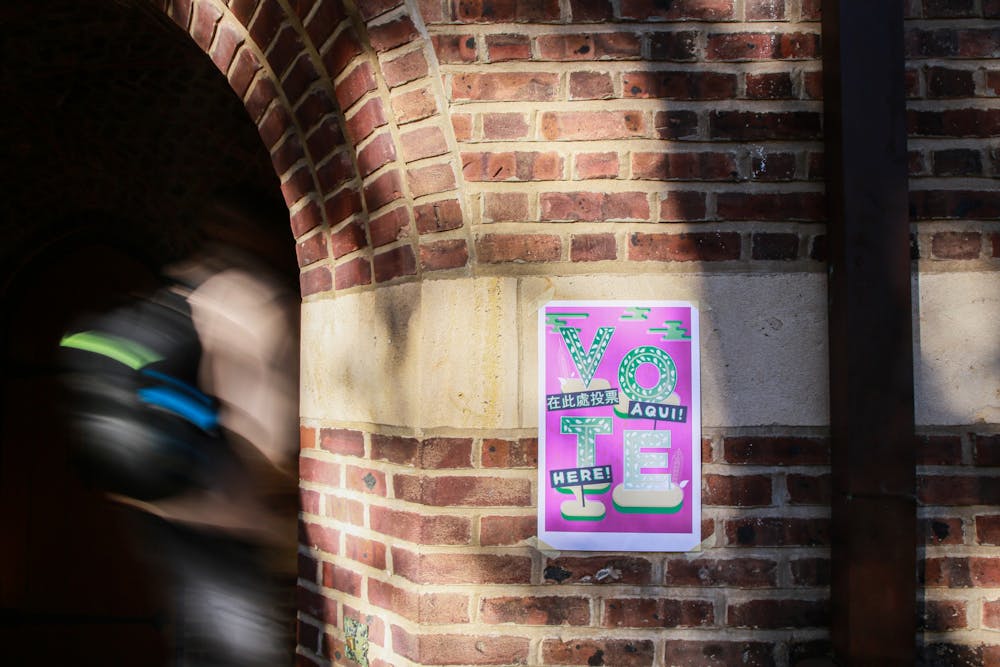A total of 2,239 campus residents cast their ballots at polling locations in Houston Hall and the ARCH building on Election Day. Pennsylvania voters decided the results of closely watched races for governor and senator in the state's midterm elections — both of which the Democratic candidates are projected to win.
Polling locations in Houston Hall’s Bodek Lounge and room 108 of the ARCH building were open from 7 a.m. to 8 p.m. 1,422 ballots were cast at the Houston Hall polling location, 604 ballots were cast at the ARCH building, and 213 ballots were cast at the Civic House.
At the Houston Hall and ARCH building polling locations, Democratic candidates Lt. Gov. John Fetterman received 90.7% of the on-campus votes for senator and Attorney General Josh Shapiro received 92.1% for governor. Republican candidates Mehmet Oz and State Sen. Doug Mastriano received 8.2% and 8.0% of on-campus votes at these locations, respectively.
As of 1 a.m. on Nov. 9, the Democratic candidates for both Senate and governor were projected to win their respective races in Pennsylvania, according to the NBC News Decision Desk.
Students reported mostly quick and easy campus voting experiences to The Daily Pennsylvanian.
In an emailed statement to The Daily Pennsylvanian, Netter Center for Community Partnerships Associate Director Cory Bowman said that while youth vote turnout is increasing across the country, Penn's turnout is "consistently and dramatically been higher than the college and university rate as a whole."
"Penn voting rate has been growing faster than the overall college and university voting rate," he wrote.
While the preliminary turnout numbers for the election are lower than 2018 midterms' total on-campus voting, Bowman said that once mail-in and absentee ballots are accounted for, he thinks "that the 2022 on-campus participation will be greater than 2018 which was greater than 2014."
RELATED:
As Election Day nears, Sen. Bernie Sanders rallies for Pa. Democrats in Philadelphia
Gubernatorial candidate Josh Shapiro talks role of Penn students in Pa. midterm election with the DP
On Election Day, student groups including Penn Democrats and Penn Leads the Vote, a nonpartisan political program that encourages civic engagement on campus, were set up outside polling locations providing voters with information about candidates and the election process.
College senior and director of PLTV Nicholas Williams said that voting ran smoothly at each of the polling locations, and that he was happy with the turnout during the day.
“It seems like a lot of students came here to vote, which is really exciting. We saw a lot of enthusiasm in terms of volunteers, people who wanted to help out the polling place,” Williams said. “And for people who turned out that they weren’t registered, we got over 30 voter registrations. So they’ll be able to vote in the next election.”
College sophomore and first-time voter Michelle Wen voted in Houston Hall, and said that even with some confusion about which district she was registered in, she found the voting process “very smooth.”
“[The voting process] was two minutes, in and out. I was very happy,” Wen said. “They definitely made it easy for college students. They walk you through it holding your hand.”
There were concerns that it would take days for Pennsylvania's races to be called. On Nov. 8, the Philadelphia City Commissioners announced that they will reinstate “poll book reconciliation,” which will delay the counting of thousands of paper ballots on election night. The decision comes in response to a lawsuit filed by Restoring Integrity and Trust in Elections, a legal advocacy group.
The process is intended to ensure that no mail-in ballots are double counted, a fear which has risen due to an increase in absentee voting since the start of the COVID-19 pandemic — though Commissioner Seth Bluestein said that double voting has not been present in the last three elections. The New York Times reported that this will result in the delay of between 15,000 and 30,000 paper ballots being counted on election night.
Wharton senior Aman Solanki, who served as an exit poll worker in West Philadelphia as a part of his political science class, said that he found his experience interesting in that he was able to speak to different voters about what was “motivating their vote.”
“Everyone there was at very different stages of life,” Solanki said. “And the way that they view the election is different than how kids on campus might, so that was the coolest part."
According to Solanki, poll workers at the 47th Street polling location said that the turnout they saw during this election was comparable to that of a typical presidential election.
Solanki, who lives off campus, voted at the Walnut Street West Library polling location. Like Wen, he said that the five-minute experience was “super easy." He said he hopes first-time voters were able to take advantage of the "accessible" voting process.
Leading up the the election, many political groups on campus have worked on registering students for the election and provided educational resources for first-time voters.
"I continue to be impressed each year with the creative new ways and impressive energy that PLTV brings to campus voter engagement," Bowman wrote. "PLTV had its most significant College House tabling efforts since 2018, and also its most significant athlete engagement program."
Senior reporter Imran Siddiqui contributed reporting.









